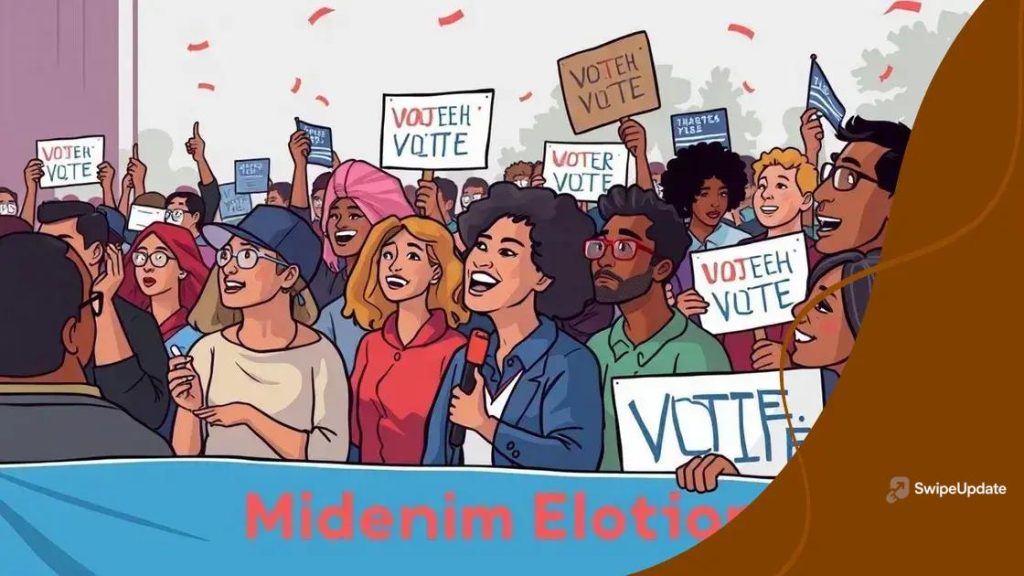Predictions for the 2026 midterm elections: What to expect

Predictions for the 2026 midterm elections highlight key factors such as voter turnout influenced by economic issues, the impact of social media on campaigns, and emerging candidates reshaping the political landscape.
Predictions for the 2026 midterm elections are already buzzing among political analysts and voters alike. Will the trends hold true as we approach election day? Let’s dive into the factors that could shape these upcoming elections.
The current political climate and its implications
The current political climate in the United States is complex and continues to evolve rapidly. Understanding its implications is crucial as we approach the midterm elections of 2026. Key factors, such as public sentiment and voter engagement, will play a significant role in shaping the outcomes.
Factors Influencing the Political Climate
Several elements are contributing to the changing political landscape. These include:
- The impact of recent high-stakes legislation
- Public reaction to social movements
- The influence of economic conditions on voter priorities
- Shifts in party ideologies and strategies
In addition to these factors, the role of media coverage cannot be overstated. As information spreads rapidly through social media, it shapes public perceptions and influences political narratives. Voters are now more informed and engaged than ever, emphasizing the importance of candidates who can resonate with their concerns.
Voter Engagement Trends
As we analyze the implications of the current climate, it’s evident that voter engagement is on the rise. This trend is fueled by:
- Increasing participation in grassroots movements
- The involvement of young voters
- Innovative campaign strategies utilizing digital platforms
These trends suggest that candidates will need to tailor their messages to connect with an increasingly diverse electorate. Moreover, understanding the local issues that motivate voters can be a determining factor for success in the upcoming elections.
Overall, the current political climate is marked by volatility and opportunity. The implications of how candidates engage with these conditions will be critical in shaping their chances during the 2026 midterms. By paying attention to the factors and trends mentioned, both voters and candidates can better navigate this dynamic environment.
Key issues likely to influence voter turnout
Understanding the key issues likely to influence voter turnout is essential in the lead-up to the 2026 midterm elections. Voter engagement often hinges on topics that resonate deeply with the public. These issues can vary but typically include economic challenges, healthcare access, and social justice matters.
Economic Concerns
Economic stability is a primary factor affecting voter participation. When people face financial difficulties, they may feel less motivated to vote. Key economic issues include:
- Inflation rates and their impact on daily life
- Job availability and wages
- Tax policies affecting middle and lower-income families
These economic challenges often drive voters to the polls, as individuals seek candidates who promise solutions to their concerns.
Healthcare Access
Healthcare remains a crucial topic, especially in the aftermath of the COVID-19 pandemic. Many voters are keenly aware of how healthcare policies impact their lives. Issues related to healthcare include:
- Access to affordable healthcare services
- Prescription drug pricing
- The future of healthcare legislation
Voters are likely to support candidates who prioritize affordable healthcare options, seeing this as essential to their well-being and future security.
Social justice has also emerged as a vital issue that influences voter turnout. Movements addressing racial inequality, police reform, and voting rights drive many to participate in the electoral process. For numerous voters, the effectiveness and commitment of candidates towards social justice can be the deciding factor in their voting choices.
Another vital aspect is environmental policy. With increasing awareness of climate change, many voters now consider candidates’ stances on environmental protection. This includes policies on renewable energy, conservation efforts, and sustainability practices. As voters become more environmentally conscious, candidates who emphasize these issues may see increased support.
Emerging candidates to watch in 2026

As the 2026 midterm elections approach, several emerging candidates are gaining attention. These individuals represent diverse backgrounds and fresh perspectives, making them important figures to watch. Their unique platforms may influence the political landscape significantly.
Key Characteristics of Emerging Candidates
Many of these candidates share several key characteristics that appeal to voters. They often prioritize:
- Grassroots fundraising over large donations
- Engaging with young voters through social media
- Addressing pressing contemporary issues
These traits can help them connect more authentically with the electorate.
Notable Candidates to Watch
Among the notable candidates, several are standing out due to their innovative approaches. Some of these candidates are:
- Aspiring progressives advocating for climate action and social justice
- Experienced leaders focusing on economic reform and community development
- Newcomers challenging the status quo with bold ideas
These individuals may reshape the current political discussions and motivate voters to engage more actively in the democratic process. Their fresh perspectives and compelling narratives can resonate well with a public eager for change.
Importantly, emerging candidates are often aligned with local issues, which helps them build a strong connection with their communities. Their ability to address local needs while maintaining broader national perspectives can set them apart from established politicians. As these new candidates gain visibility, media coverage will point to their strategies and how they might influence voter turnout in 2026.
Impact of social media on elections
The impact of social media on elections is profound and undeniable. As we approach the 2026 midterm elections, social media will play a crucial role in how candidates connect with voters. Many people get their news and political information from various social media platforms, making it a vital tool for campaigning and engagement.
How Social Media Shapes Political Discourse
Social media platforms like Twitter, Facebook, and Instagram give candidates direct access to voters. Candidates can share their messages without a filter, allowing them to present their views authentically. Some of the ways social media shapes political discourse include:
- Instant communication with supporters and opponents
- The ability to spread campaign messages rapidly
- Engaging in conversations about pressing issues
- Mobilizing and organizing grassroots movements
The immediacy of social media allows candidates to react quickly to current events, shaping their image in real-time.
Voter Engagement and Turnout
Social media also has a significant impact on voter engagement. When candidates use these platforms effectively, they can motivate and mobilize voters. Some key elements include:
- Targeted ads reaching specific demographics
- Interactive content that encourages discussion
- Live events and Q&A sessions that draw attention
By providing platforms for dialogue and interaction, social media empowers voters to become more involved in the electoral process.
Moreover, misinformation is a challenge on social media. False information can spread quickly, creating confusion among voters. This highlights the need for robust media literacy among the electorate. Candidates must strive to communicate with clarity, ensuring their supporters can discern accurate information from misleading content.
Ultimately, the influence of social media in elections cannot be overlooked. Its power lies in its ability to enhance communication, influence perceptions, and drive voter participation.
Historical trends and their relevance today
Analyzing historical trends is essential to understanding the current political landscape as we approach the 2026 midterm elections. Past elections often reveal patterns that can help predict future outcomes. By looking at these trends, voters can gain insights into what to expect.
Voting Patterns Over Time
One significant trend is the demographic shift in voter turnout. Over recent years, certain groups have become more active in the electoral process. This includes:
- Increased participation from younger voters
- A rise in turnout among minority groups
- Changes in the voting preferences of suburban populations
These shifts indicate that candidates must tailor their messages to resonate with these diverse populations.
Influence of Major Events
Historical events often impact voter behavior. For example, the effects of the COVID-19 pandemic have been substantial. Voters are more concerned about health and economic issues than ever before. Similarly, social movements for racial justice and climate change have mobilized many individuals. These events can create a sense of urgency among voters, making them more likely to participate.
Furthermore, looking at past election results can reveal how incumbents fared during challenging times. Historically, many incumbents in times of crisis face strong opposition, suggesting that the upcoming elections may be competitive.
The use of technology in campaigns has also evolved. Past trends show a growing reliance on digital platforms for outreach. This shift impacts how candidates engage with voters, particularly younger ones who predominantly use social media for information. Candidates must continue to adapt their strategies to stay relevant.
Understanding these historical trends allows both candidates and voters to navigate the complexities of modern elections. As the political climate shifts, drawing lessons from history can provide valuable guidance for making informed decisions during the midterms.
FAQ – Questions about the 2026 Midterm Elections
What key issues are expected to influence voter turnout in 2026?
Key issues include economic concerns, healthcare access, and social justice, all of which resonate deeply with voters.
How does social media impact elections?
Social media allows candidates to engage directly with voters, spreading their messages quickly and mobilizing their supporters.
What historical trends should voters consider for the 2026 elections?
Voters should consider demographic shifts, past voter turnout patterns, and how historical events have influenced current political sentiments.
Who are the emerging candidates to watch in the upcoming elections?
Emerging candidates include progressives focusing on climate action and social justice, as well as new leaders challenging the status quo.
